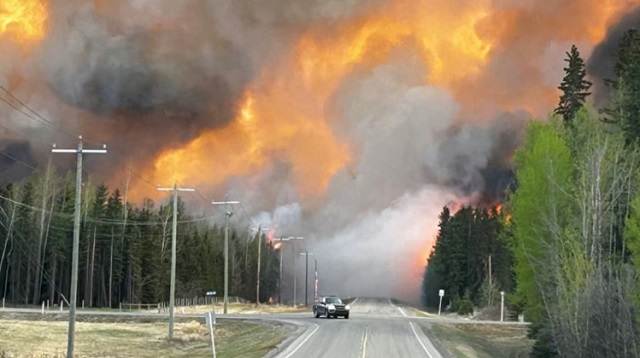Alberta
Thank the beetle and deadwood ‘fuel’ that should have been cleared

By Josh Andrus
Originally posted in the Western Standard
Parks Canada officials admit they failed to conduct controlled burns of dead pine trees, which now pose a significant fire risk.
While Ottawa fixates on climate change rhetoric, their neglect of forest fire prevention has left Alberta’s landscapes vulnerable to devastation.
Last week, a shining beacon of the beauty of our province was partially destroyed as a wildfire burned through the picturesque town of Jasper. Our thoughts and prayers go out to the victims.
Thankfully there has been no reported loss of life. But many people’s livelihoods have been wiped out. The question is how did this happen, and what could have been done to prevent it?
Smokey Bear’s famous saying was: “Only you can prevent forest fires.” And, in this case, proactive measures certainly could have made a difference.
Unfortunately, the entire federal government seems to have forgotten Smokey’s key point. Fire prevention on national park land is federal jurisdiction.
In 2022, Environment Minister Steven Guilbeault was informed that Parks Canada managers had not taken adequate precautions to protect the Town of Jasper from wildfires, according to documents obtained by Blacklock’s Reporter. At that time, Parks Canada officials admitted they had failed to conduct controlled burns of dead pine trees, which posed a significant fire risk.
“A mountain pine beetle infestation has brought significant changes to forests in Alberta, including Jasper National Park, with consequences for wildfire risk,” Guilbeault was informed.
Almost half of Jasper’s Whitebark Pine forest, 44%, was infected by beetles. However, few steps were taken to reduce the risk to the Town of Jasper with controlled burns of the surrounding forest, records show.
“Fire has not yet been applied for Whitebark Pine restoration,” stated a 2022 implementation report. “Mechanical thinning has been completed in 1.6 hectares, which is a small area relative to the amount of Whitebark Pine habitat.”
No reason was given for failing to take precautions. Since the fire, Guilbeault has made no public mention of the management reports.
Even though federal officials, including his department, knew the raging pine beetle was a serious hazard, Guilbeault blamed climate change: “As we are seeing in Canada and all around the world, we are seeing more and more aggressive forest fires,” he said on a media call on Monday.
Landon Shepherd, Incident Commander for Parks Canada, also attributed the intensity of the blazes to climate change: “This isn’t meant to be a discussion about climate change, but anyone who’s involved in fire management can tell you that things have become more difficult, especially in the last five years, to manage impacts.”
The 2022 warnings were not the first time concerns about a lack of fire prevention in national parks have been raised.
In 2018, CBC reported concerns from experts. Emile Begin and Ken Hodges, foresters for 40 years who had been studying Jasper National Park, found multiple issues with the forest that make it susceptible to a fire.
“You have fire suppression that has occurred for many years — therefore, you get a lot of dead fuel that would have been consumed by a natural process,” Hodges said. “The mountain pine beetle adds even more fuel to the situation.”
“You’ve got a major catastrophe on your hands if you get a match thrown into that.”
When pressed about the concerns, Alan Fehr, a superintendent for Jasper National Park, said: “We’re quite comfortable with where we are with our own emergency planning and evacuation planning.”
Hodges disagreed: “The potential that’s out there is actually scary. Hopefully, we’re wrong.”
Despite the repeated warnings of potential devastation due to forest management practices, Ottawa continues to point to climate change as the cause of the fires.
The Alberta government has been preparing, and increased its firefighting budget by more than 50% to $155.4 million this year. Alberta’s firefighting budget is now the highest it has ever been (despite misinformation about cuts.)
However, without proper fire prevention on national park land, blazes can become out of control quickly — as the warnings indicated.
Smokey Bear would be horrified. Clearly, Ottawa needs to spend less time interfering in provincial jurisdiction and more time focusing on things that actually are federal jurisdiction, like fire prevention in national parks.
Their inability to see the forest through the trees and take legitimate action to protect our national parks from the fury of an out-of-control wildfire demonstrates a degree of ineptitude that is, quite frankly, shocking.
Ottawa needs to stay in its lane and focus on its own jurisdiction, and they need to stop blaming climate change for their own ineptitude.
Alberta
Alberta Provincial Police – New chief of Independent Agency Police Service

Sat Parhar has been appointed as the first chief of the Independent Agency Police Service, marking the next step toward a new municipal policing option.
The appointment of a new chief for the Independent Agency Police Service (IAPS) marks the next step in giving municipalities a new option for local policing and builds on the work already underway for the agency to assume the police-like duties currently carried out by the Alberta Sheriffs. The IAPS will empower municipalities to adopt strategies that effectively respond to their specific safety concerns, enhancing public safety across the province.
Chief Parhar brings more than 25 years of policing experience, including senior roles with the Calgary Police Service, most recently as deputy chief. His frontline policing experience and deep understanding of Alberta’s complex and diverse public safety landscape positions him to lead the agency as it takes shape and begins its work as a new municipal policing option, keeping communities safe.
Once operational, the agency will strengthen Alberta’s existing policing model and complement the province’s current police services, which includes the RCMP, Indigenous policing services and municipal police. It will help fill gaps and ensure law enforcement resources are deployed efficiently to meet Alberta’s evolving public safety needs and improve law enforcement response times, particularly in rural communities.
“Appointing Chief Sat Parhar is a key milestone in Alberta’s plan to give municipalities a real choice in how their communities are kept safe. This is about building a modern police service that reflects the priorities of Albertans, strengthens local decision-making, and ensures every corner of our province, especially rural areas, can count on responsive, effective law enforcement. With his decades of experience and deep understanding of Alberta’s policing landscape, he is the right leader to bring this vision to life.”
“This appointment signifies a significant step forward in our efforts to establish a more robust, community-focused policing model that is better equipped to meet the unique needs of our local residents. Under Chief Parhar’s visionary leadership, we are confident that we will develop a modern, efficient police service that not only enhances public safety but also aligns closely with the priorities and values of Albertans. His experience and commitment are vital in shaping an IAPS that is responsive, transparent, and dedicated to fostering trust and collaboration within the community, ultimately ensuring a safer and more connected society for all.”
Chief Parhar’s immediate priorities will be to hire an executive team and commence organizational planning such as developing key recruitment, training and other operational policies. Chief Parhar’s appointment is the first step of many to establishing the IAPS.
“It’s an honour to take on this role and help shape a modern police service built for Alberta. My focus from day one will be on setting high standards for professionalism, building strong relationships with our partners and ensuring this service reflects the needs and priorities of the communities we serve.”
The Independent Agency Police Service was formally created through regulation following the passing of Public Safety Statutes Amendment Act, 2024. The agency will operate as an independent Crown corporation, and will be renamed the Alberta Sheriffs Police Service, with its head office located in Calgary. The IAPS will be operationally independent from the provincial government with civilian oversight, consistent with all police services in Alberta.
“When it comes to policing, municipalities like ours deserve a choice – especially when the current system leaves us disadvantaged simply because of our size. We look forward to learning more about what that alternative will look like once an Alberta police agency is fully established and the options are clear. For us, this is about fairness, sustainability, and ensuring municipalities have access to policing solutions that reflect both their needs and their realities.”
Quick facts
- The regulation establishes the IAPS Provincial Corporation and its governance structure including board of directors, board of director powers, financial responsibilities and accountabilities.
Related news
- Expanding municipal police service options (April 7, 2024)
Alberta
Pierre Poilievre – Per Capita, Hardisty, Alberta Is the Most Important Little Town In Canada

From Pierre Poilievre
-

 Crime2 days ago
Crime2 days agoNational Health Care Fraud Takedown Results in 324 Defendants Charged in Connection with Over $14.6 Billion in Alleged Fraud
-

 Health2 days ago
Health2 days agoRFK Jr. Unloads Disturbing Vaccine Secrets on Tucker—And Surprises Everyone on Trump
-

 Business1 day ago
Business1 day agoElon Musk slams Trump’s ‘Big Beautiful Bill,’ calls for new political party
-

 Business15 hours ago
Business15 hours agoWhy it’s time to repeal the oil tanker ban on B.C.’s north coast
-

 Censorship Industrial Complex1 day ago
Censorship Industrial Complex1 day agoGlobal media alliance colluded with foreign nations to crush free speech in America: House report
-

 International23 hours ago
International23 hours agoCBS settles with Trump over doctored 60 Minutes Harris interview
-

 Business15 hours ago
Business15 hours agoLatest shakedown attempt by Canada Post underscores need for privatization
-

 Energy15 hours ago
Energy15 hours agoIf Canada Wants to be the World’s Energy Partner, We Need to Act Like It






